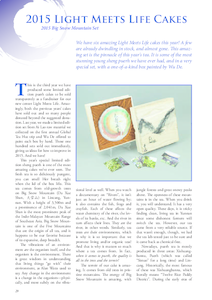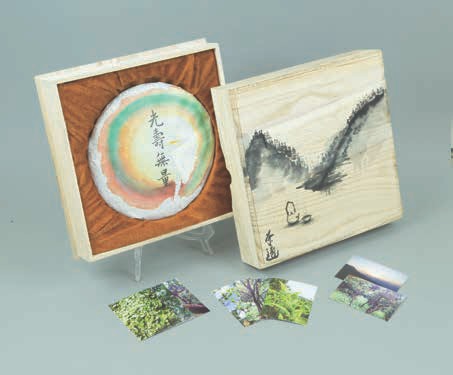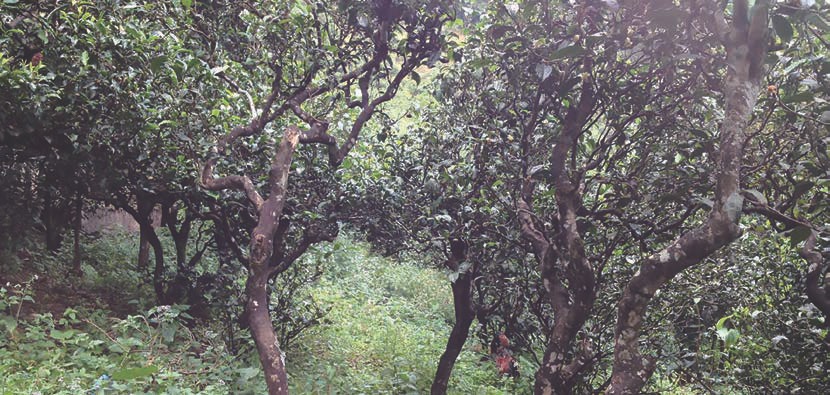
 |
|

This is the third year we have produced some limited edition puerh cakes to be sold transparently as a fundraiser for our new center Light Meets Life. Amazingly, both the previous years' cakes have sold out and so many people donated beyond the suggested donation. Last year, we made a limited edition set from Ai Lao raw material we collected on the first annual Global Tea Hut trip and Wu De offered to paint each box by hand. Those one hundred sets sold out immediately, giving us ideas for how to improve in 2015. And we have!
This year's special limited edition sheng puerh is one of the most amazing cakes we've ever seen. The fresh tea is so deliciously pungent, you can smell Her breath right when the lid of the box lifts. This tea comes from old-growth trees on Big Snow Mountain (Da Xue Shan, 大雪山) in Lincang, Yunnan. With a height of 3,500m and a prominence of 2,041m, Da Xue Shan is the most prominent peak of the Indo-Malayan Mountain Range of Southeast Asia. Big Snow Mountain is one of the Five Mountains that are the origin of all tea, and it happens to be our favorite because of its expansive, deep breadth.
The vibrations of an environment are the organism itself, and the organism is the environment. There is great wisdom in understanding that living things "go with" their environment, as Alan Watts used to say. Any change in the environment is a change in the organism - physically, and more subtly on the vibrational level as well. When you watch a documentary on "Rivers", it isn't just an hour of water flowing by; it also contains the fish, frogs and crayfish. Each of these affects the water chemistry of the river, the levels of its banks, etc. And the river in turn affects their lives. They are the river, in other words. Similarly, tea trees are their environments, which is why it is so important that we promote living and/or organic teas! And that is why it matters so much where a tea comes from. In fact, when it comes to puerh, the quality is all in the trees and the terroir!
The terroir of our cake is amazing. It comes from old trees in pristine mountains. The energy of Big Snow Mountain is amazing, with jungle forests and great snowy peaks above. The openness of these mountains is in the tea. When you drink it, you will understand. It has a very open quality. These days, it is tricky finding clean, living tea in Yunnan since some dishonest farmers will switch the tea. However, our tea came from a very reliable source. If that wasn't enough, though, we had the tea lab-tested just to be sure and it came back as chemical-free.
Nowadays, puerh tea is mostly produced in three areas: Xishuangbanna, Puerh (which was called "Simao" for a long time) and Lincang. Historically, the most famous of these was Xishuangbanna, which literally means "Twelve Rice Paddy District". During the early eras of
Puerh, almost all commercial tea came from this region. It is in the very south of Yunnan. The Lincang region is the northernmost of the three major tea areas in Yunnan. It is also the birthplace of all tea. The forests there have the oldest trees, and the deepest roots in Cha Dao. There is some disagreement amongst scholars as to the origin of tea, but in traveling to the three major areas of Yunnan, we have found that the Lincang region is the home of all tea. We especially feel this in the "Five Mountains". Our understanding, however, is based more on a feeling, a connection and affinity to Tea and Her spirit than on any linear proof - take it or leave it... The Five Mountains all tea originated from are:
This tea was handpicked and processed by the Wa aboriginal tribe. It is a very rare and limited treasure that was hard to find. Each 400g cake was completely stonepressed by hand in the traditional way, leaving them looser, which is better for aging. These days most puerh that is labeled as "stonepressed" is actually only partially so. They will press the cake on a machine and then finish under stones so that they can label it as such, which we have witnessed many times in Yunnan. A complete stone-pressing takes longer and is easily discernible in the looseness of the cake, especially when the leaves are high quality. Better tea leaves are juicy and will resist the compression, machine or stone, meaning that great stone-pressed cakes will be doubly loose. This is ideal, as the tea will be easier to break up for brewing without damaging the leaves. Also, this provides the perfect environment for storing in normal humidity conditions, as the tea is not too tight to slow down aging, but still better than loose-leaf (which you will know if you did last month's gongfu experiment).
We find the liquor ethereal beyond description. The color is perfectly white and golden, shining bright in any light. It is both light and deep, uplifting and centering. It is crisp and clean and tastes like wind, but it has the strength of young puerh as well, which means it will go the distance. It is a great candidate for aging or drinking young.
One of the things we felt we had to improve last year was the boxes. While they were nice last year, they didn't have an insert for the cake, which we made ourselves by folding paper. This year, we made boxes from the same wood, but with inserts to hold the cake in, which means you can also display the cakes upright. Each box is different, with a unique painting hand done by Wu De. For many of us, some of the value will be in this as well. Wu has already spent dozens of hours painting these boxes. The set also comes with a description card and eight photos of the mountain and trees.
Of course, all the proceeds from the 120 numbered cakes will support the creation of our new center, Light Meets Life. In this way, the old and wise trees will be contributing to our Way of Tea through bowls of joy and new centers to share those bowls in... The minimum donation for these amazing sets is 150$ + shipping. Maocha from old trees is very expensive these days. Our cost was around 100$ for the tea, boxes and photos, not including Wu De's time or art, which he's donated freely.
We have already sold more than one-third of the available sets, so if you are interested in getting one you should order yours today. We must, of course, express our deep and heartfelt gratitude for your support!
